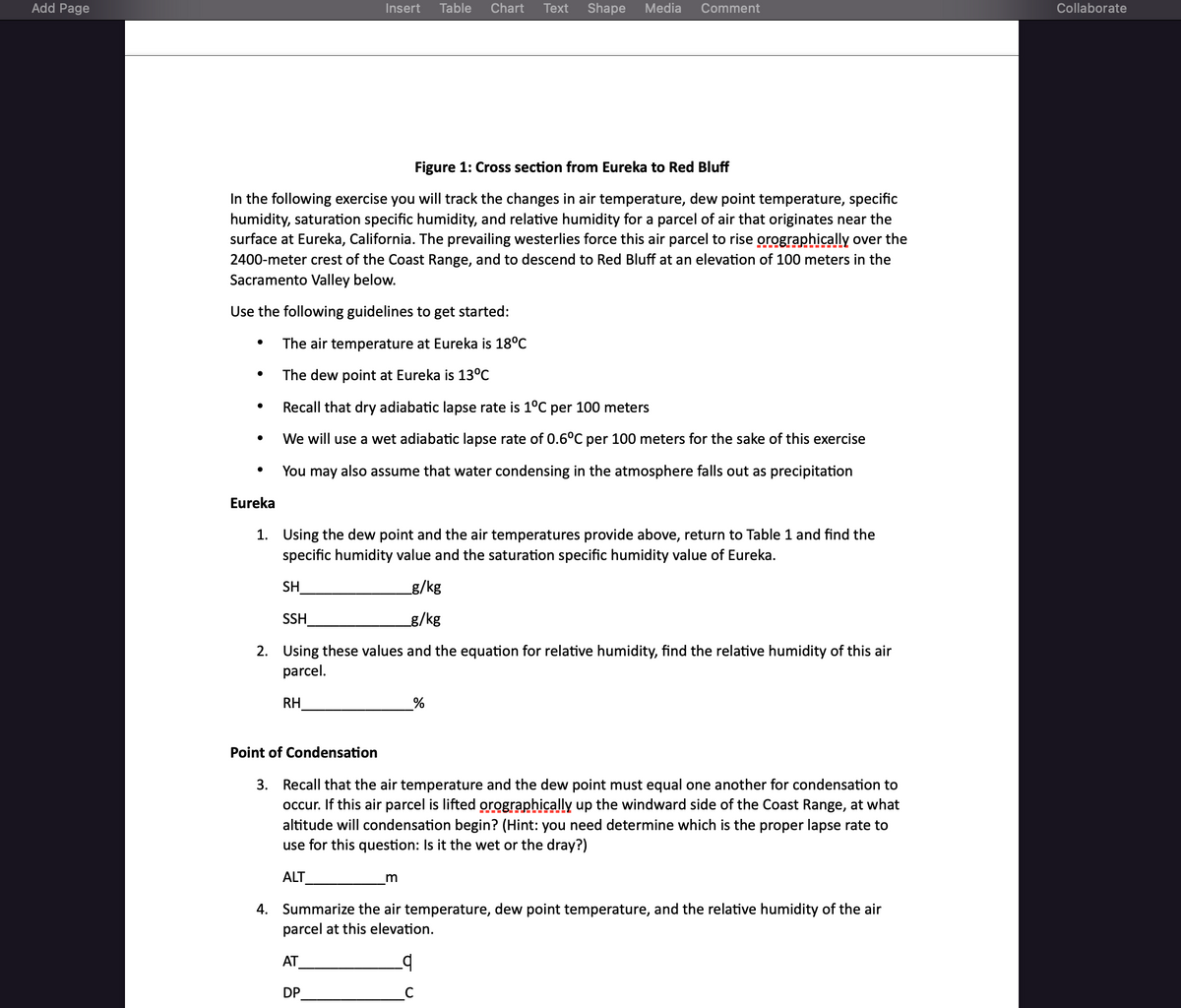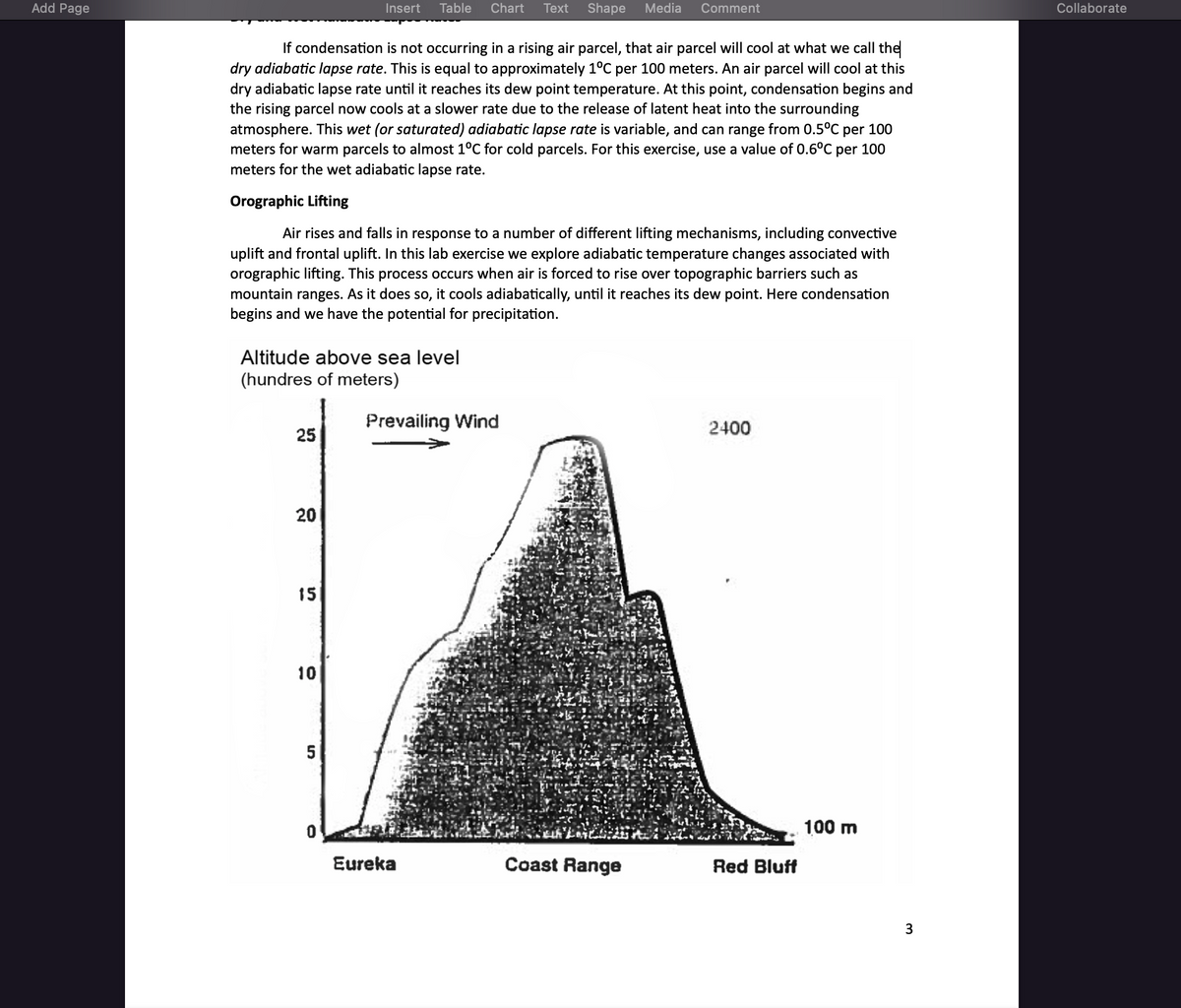Figure 1: Cross section from Eureka to Red Bluff In the following exercise you will track the changes in air temperature, dew point temperature, specific humidity, saturation specific humidity, and relative humidity for a parcel of air that originates near the surface at Eureka, California. The prevailing westerlies force this air parcel to rise orographically over the 2400-meter crest of the Coast Range, and to descend to Red Bluff at an elevation of 100 meters in the Sacramento Valley below. Use the following guidelines to get started: • The air temperature at Eureka is 18°C The dew point at Eureka is 13°C Recall that dry adiabatic lapse rate is 1°C per 100 meters We will use a wet adiabatic lapse rate of 0.6°C per 100 meters for the sake of this exercise You may also assume that water condensing in the atmosphere falls out as precipitation ● . ● Eureka 1. Using the dew point and the air temperatures provide above, return to Table 1 and find the specific humidity value and the saturation specific humidity value of Eureka. SH _g/kg _g/kg SSH 2. Using these values and the equation for relative humidity, find the relative humidity of this air parcel. RH % Point of Condensation 3. Recall that the air temperature and the dew point must equal one another for condensation to occur. If this air parcel is lifted orographically up the windward side of the Coast Range, at what altitude will condensation begin? (Hint: you need determine which is the proper lapse rate to use for this question: Is it the wet or the dray?) ALT m
Figure 1: Cross section from Eureka to Red Bluff In the following exercise you will track the changes in air temperature, dew point temperature, specific humidity, saturation specific humidity, and relative humidity for a parcel of air that originates near the surface at Eureka, California. The prevailing westerlies force this air parcel to rise orographically over the 2400-meter crest of the Coast Range, and to descend to Red Bluff at an elevation of 100 meters in the Sacramento Valley below. Use the following guidelines to get started: • The air temperature at Eureka is 18°C The dew point at Eureka is 13°C Recall that dry adiabatic lapse rate is 1°C per 100 meters We will use a wet adiabatic lapse rate of 0.6°C per 100 meters for the sake of this exercise You may also assume that water condensing in the atmosphere falls out as precipitation ● . ● Eureka 1. Using the dew point and the air temperatures provide above, return to Table 1 and find the specific humidity value and the saturation specific humidity value of Eureka. SH _g/kg _g/kg SSH 2. Using these values and the equation for relative humidity, find the relative humidity of this air parcel. RH % Point of Condensation 3. Recall that the air temperature and the dew point must equal one another for condensation to occur. If this air parcel is lifted orographically up the windward side of the Coast Range, at what altitude will condensation begin? (Hint: you need determine which is the proper lapse rate to use for this question: Is it the wet or the dray?) ALT m
Applications and Investigations in Earth Science (9th Edition)
9th Edition
ISBN:9780134746241
Author:Edward J. Tarbuck, Frederick K. Lutgens, Dennis G. Tasa
Publisher:Edward J. Tarbuck, Frederick K. Lutgens, Dennis G. Tasa
Chapter1: The Study Of Minerals
Section: Chapter Questions
Problem 1LR
Related questions
Question

Transcribed Image Text:Add Page
●
Figure 1: Cross section from Eureka to Red Bluff
In the following exercise you will track the changes in air temperature, dew point temperature, specific
humidity, saturation specific humidity, and relative humidity for a parcel of air that originates near the
surface at Eureka, California. The prevailing westerlies force this air parcel to rise orographically over the
2400-meter crest of the Coast Range, and to descend to Red Bluff at an elevation of 100 meters in the
Sacramento Valley below.
Use the following guidelines to get started:
The air temperature at Eureka is 18°C
The dew point at Eureka is 13°C
Recall that dry adiabatic lapse rate is 1°C per 100 meters
We will use a wet adiabatic lapse rate of 0.6°C per 100 meters for the sake of this exercise
You may also assume that water condensing in the atmosphere falls out as precipitation
●
Eureka
1.
Insert Table
Using the dew point and the air temperatures provide above, return to Table 1 and find the
specific humidity value and the saturation specific humidity value of Eureka.
SH
SSH
_g/kg
_g/kg
2. Using these values and the equation for relative humidity, find the relative humidity of this air
parcel.
RH
AT
Chart Text Shape Media Comment
Point of Condensation
3. Recall that the air temperature and the dew point must equal one another for condensation to
occur. If this air parcel is lifted orographically up the windward side of the Coast Range, at what
altitude will condensation begin? (Hint: you need determine which is the proper lapse rate to
use for this question: Is it the wet or the dray?)
ALT
DP
%
m
4. Summarize the air temperature, dew point temperature, and the relative humidity of the air
parcel at this elevation.
_q
Collaborate

Transcribed Image Text:Add Page
25
If condensation is not occurring in a rising air parcel, that air parcel will cool at what we call the
dry adiabatic lapse rate. This is equal to approximately 1°C per 100 meters. An air parcel will cool at this
dry adiabatic lapse rate until it reaches its dew point temperature. At this point, condensation begins and
the rising parcel now cools at a slower rate due to the release of latent heat into the surrounding
atmosphere. This wet (or saturated) adiabatic lapse rate is variable, and can range from 0.5°C per 100
meters for warm parcels to almost 1°C for cold parcels. For this exercise, use a value of 0.6°C per 100
meters for the wet adiabatic lapse rate.
Orographic Lifting
Air rises and falls in response to a number of different lifting mechanisms, including convective
uplift and frontal uplift. In this lab exercise we explore adiabatic temperature changes associated with
orographic lifting. This process occurs when air is forced to rise over topographic barriers such as
mountain ranges. As it does so, it cools adiabatically, until it reaches its dew point. Here condensation
begins and we have the potential for precipitation.
Altitude above sea level
(hundres of meters)
20
15
10
Insert
5
0
Table Chart Text
Prevailing Wind
Eureka
Shape Media Comment
Coast Range
2400
Red Bluff
100 m
3
Collaborate
Expert Solution
This question has been solved!
Explore an expertly crafted, step-by-step solution for a thorough understanding of key concepts.
This is a popular solution!
Trending now
This is a popular solution!
Step by step
Solved in 2 steps

Recommended textbooks for you

Applications and Investigations in Earth Science …
Earth Science
ISBN:
9780134746241
Author:
Edward J. Tarbuck, Frederick K. Lutgens, Dennis G. Tasa
Publisher:
PEARSON

Exercises for Weather & Climate (9th Edition)
Earth Science
ISBN:
9780134041360
Author:
Greg Carbone
Publisher:
PEARSON

Environmental Science
Earth Science
ISBN:
9781260153125
Author:
William P Cunningham Prof., Mary Ann Cunningham Professor
Publisher:
McGraw-Hill Education

Applications and Investigations in Earth Science …
Earth Science
ISBN:
9780134746241
Author:
Edward J. Tarbuck, Frederick K. Lutgens, Dennis G. Tasa
Publisher:
PEARSON

Exercises for Weather & Climate (9th Edition)
Earth Science
ISBN:
9780134041360
Author:
Greg Carbone
Publisher:
PEARSON

Environmental Science
Earth Science
ISBN:
9781260153125
Author:
William P Cunningham Prof., Mary Ann Cunningham Professor
Publisher:
McGraw-Hill Education

Earth Science (15th Edition)
Earth Science
ISBN:
9780134543536
Author:
Edward J. Tarbuck, Frederick K. Lutgens, Dennis G. Tasa
Publisher:
PEARSON

Environmental Science (MindTap Course List)
Earth Science
ISBN:
9781337569613
Author:
G. Tyler Miller, Scott Spoolman
Publisher:
Cengage Learning

Physical Geology
Earth Science
ISBN:
9781259916823
Author:
Plummer, Charles C., CARLSON, Diane H., Hammersley, Lisa
Publisher:
Mcgraw-hill Education,